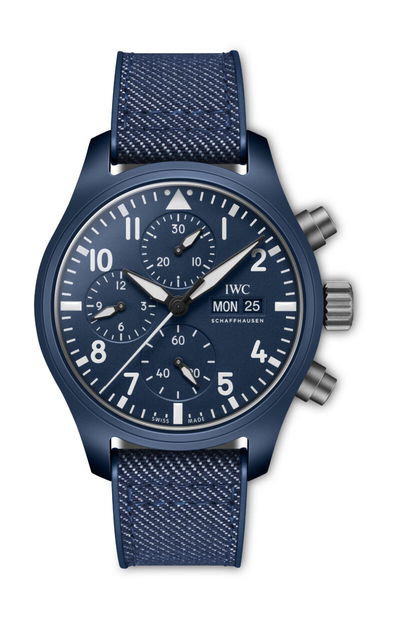
IWC Schaffhausen Watches
Swiss watch brand IWC Schaffhausen has the unique history of being founded by an American in 1868. Florentine Ariosto Jones of Boston sailed to Switzerland to find a place to produce the watches of his dreams. He established the first true production facility for watchmaking, harnessing the power of the Rhine River. Today, IWC is owned by the Richemont Group and is known for its complications, pilot’s watches, Aquatimer dive watches, and the beloved Portugieser and Portofino collections.
-
Price
- ()
















































































History of IWC Schaffhausen
The International Watch Company (IWC) is a luxury watch manufacturer headquartered in Schaffhausen, Switzerland. Florentine Ariosto Jones, an American, founded the company in 1868 to combine Swiss watchmaking craftsmanship with American engineering techniques to manufacture watch movements and components.
With the assistance of watch manufacturer Heinrich Moser, who built the town’s first hydroelectric plant, Jones rented the first factory in Schaffhausen in 1869. IWC quickly expanded its watch production with the help of local watchmakers, and by 1875 the company moved its factory to a privately owned building.
Johann Rauschenbach-Vogel, a machine manufacturer from Schaffhausen, took over the IWC in 1880 and renamed it Uhrenfabrik von J. Rauschenbach. A year later, in 1881, Johann Rauschenbach-Vogel passed away, leaving his son Johannes Rauschenbach-Schenk to run the company. The brand’s first horological discovery occurred in 1885, when IWC introduced of the world’s first digital watch.
After Johannes Rauschenbach-Schenk died in 1905 his son-in-law Ernst Jakob Homberger took over the company and renamed it Uhrenfabrik von Ernst Homberger-Rauschenbach. Between 1930 and 1945, IWC was one of five watch manufacturers that built observation watches (B-Uhren) for the German air force.
During the 1970s and 1980s, the Swiss watchmaking industry underwent a far-reaching technological change due to the quartz crisis and the explosive rise in gold prices. For the sake of survival, IWC, under the leadership of Director and CEO Otto Heller, developed a line of high-quality pocket watches and set up its modern wristwatch and case manufacturing facilities.
In 1991, IWC director Günter Blümlein founded the LMH Group with its headquarters in Schaffhausen. It had a 100% stake in IWC, a 60% stake in Jaeger-LeCoultre, and a 90% stake in A. Lange & Söhne. In July 2000, Richemont acquired LMH for CHF 2.8 billion.
IWC First Digital Watch 1855
The IWC 1885 pocket watch was the first pocket watch with a digital display, demonstrating the brand’s remarkable spirit of innovation. The timepiece resulted from a patent granted to an Austrian named Pallweber. Instead of a conventional dial, this watch featured a jumping hour mechanism and two windows for hours and minutes.
IWC’s Most Expensive Timepiece
IWC’s most expensive watch is the Portuguese Sidéral Scafusia. IWC developed this model over ten years, making it the most complex watch they ever produced. The Constant-Force Tourbillon on this watch was one of the biggest highlights, along with a 96-hour power reserve and a Sidéral time display. In addition, the watch featured an astronomical dial and a celestial chart on the back. The watch retailed for 750,000 USD.
Who Owns IWC?
Richemont Group, a Swiss luxury goods holding company, owns IWC and runs IWC alongside other brands, including Mont Blanc, Cartier, and Vacheron-Constantin.
Fun Fact – The IWC Museum
The IWC museum is located on the ground floor of the manufacture and features a wide variety of exhibits, including the first timepiece made by the company. In addition, an exciting exhibition at the museum traces the development of the IWC Aquatimer collection from 1967 to 2014.
IWC Collections
Portugieser Collection
IWC Schaffhausen’s Portugieser collection combines traditional values and design with modern watchmaking technology. This collection includes classically elegant chronographs, automatic three-hand watches, and highly complicated watches, such as perpetual calendars and minute repeaters.
Pilot’s Watches Collection
IWC is perhaps the most closely associated Swiss watchmaker with pilot’s watches. They feature luminous Arabic numerals and indices and cathedral-style sword hands for easy reading. With over 50 models, the current collection features everything from three-hand timepieces to chronographs to pilot watches with tourbillons.
Portofino Collection
The IWC Portofino collection includes minimalist, sophisticated, and delicate watches. This collection features timepieces with round cases made from polished gold or stainless steel. Aside from being gorgeous, these watches have in-house movements and feature complications like perpetual calendar and tourbillon.
Da Vinci Collection
IWC Schaffhausen has repeatedly reimagined its Da Vinci series over the years. Despite these differences, all timepieces have some common characteristics: an elegant design, quality materials, and sophisticated complications.
Ingenieur Collection
The IWC Schaffhausen Ingenieur collection has been a pillar of its catalog since 1955. The inner ring of these watches is made of soft iron, which protects from magnetic fields. This collection includes watches like Ingenieur Reference 666 and Ingenieur Perpetual Calendar Digital Date and Month.
Aquatimer Collection
The IWC Auatimer collection includes diving watches. A useful feature of this collection is its ability to measure safe diving time with the internal ring. The Aquatimer collection also contains special edition mechanical chronographs, such as Galapagos Islands Edition and Jacques-Yves Cousteau Edition.
